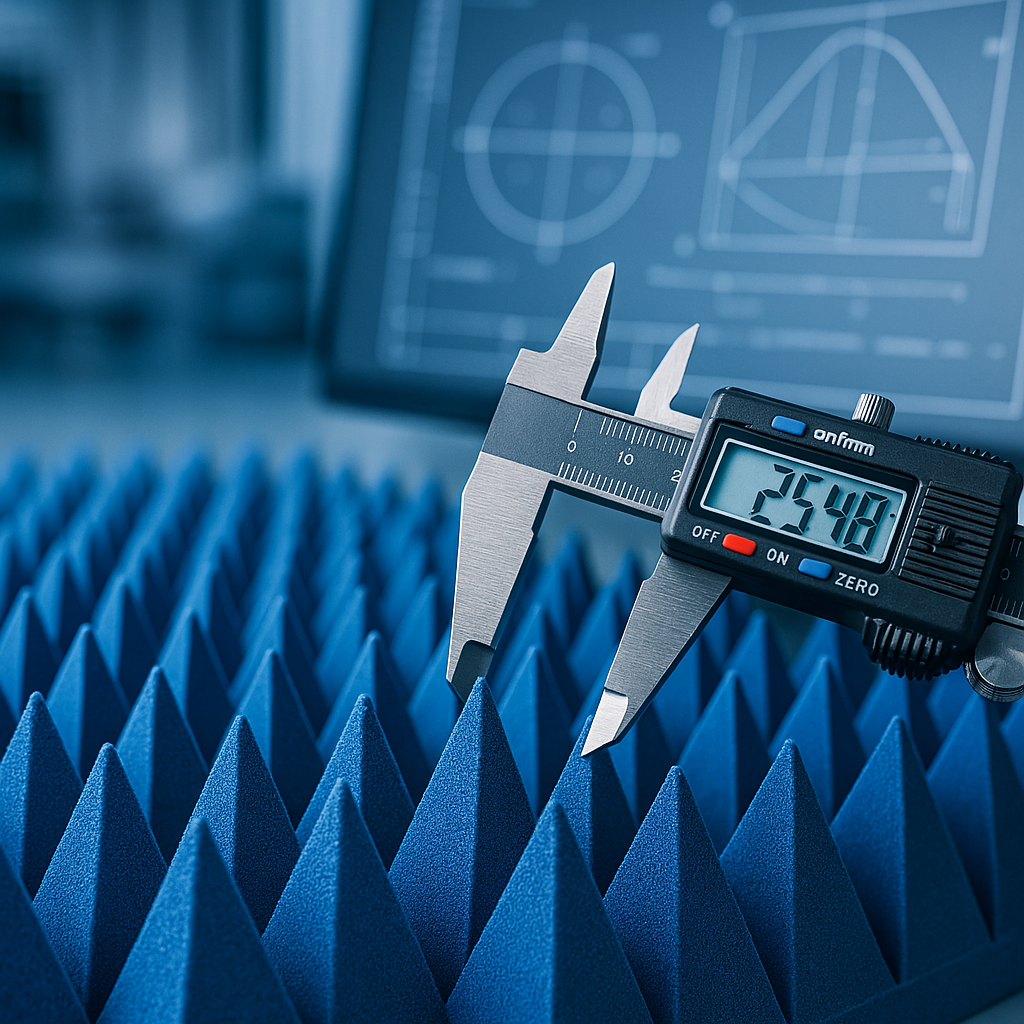A Comprehensive Guide to RF Shielding in Telecommunication Systems

A Comprehensive Guide to RF Shielding in Telecommunication Systems
Radiofrequency shielding is integral to telecommunication systems, ensuring that electromagnetic interference (EMI) is minimized and signal integrity is maintained. This comprehensive guide covers RF shielding materials, design strategies, testing methods, and proper application for effective performance in modern communication systems.
Definition and Purpose of RF Shielding in Telecommunications
In telecommunication systems, radio frequency shielding (RF shielding) refers to protection against unwanted electromagnetic interference (EMI) that could disrupt signal transmission. RF shielding is designed to prevent external RF signals from entering sensitive electronic systems while also containing any internally generated RF signals that could interfere with other devices or systems.
The importance of minimizing interference in RF systems cannot be overstated. Telecommunication systems rely heavily on clear, uninterrupted signal transmission for applications ranging from mobile communication to satellite data transfer. Even slight disturbances caused by electromagnetic waves can result in signal degradation, causing poor call quality, loss of data, or even complete system failure.
The primary purpose of radio wave shielding in telecommunications is to maintain the integrity of the transmitted signals. RF protection materials create barriers that absorb or reflect incoming interference, preventing these signals from affecting the sensitive equipment within the system. By minimizing the impact of external interference, interference protection ensures that telecommunication systems function reliably and securely without disruptions from stray electromagnetic radiation.

Understanding the Basics of RF Protection
What is RF Shielding and How Does It Work?
Radio wave shielding operates on the principle of preventing the penetration of electromagnetic waves into sensitive areas. Several mechanisms can block these waves, including reflection, absorption, and scattering. The materials used in RF shielding are selected based on their ability to effectively reflect or absorb electromagnetic radiation, creating a protective shield around the system.
When an external electromagnetic wave encounters a shielded surface, it is either reflected, absorbed by the material, or transmitted. In the case of effective shielding, most of the wave is either reflected or absorbed, preventing interference with the systems inside. The effectiveness of this shielding depends on the material used, its thickness, and its specific properties.
Active vs. Passive Shielding
RF shielding solutions can be categorized into active and passive shielding. Passive shielding involves materials blocking or absorbing electromagnetic waves without external power. These include metals like copper, aluminum, and specialized conductive fabrics, which naturally block or absorb RF signals.
On the other hand, active shielding requires an external power source to generate signals that counteract incoming interference. Active systems are more complex and are typically used in applications where higher levels of shielding are required, such as in satellite communication systems or high-security areas. While passive shielding is more common, active shielding is becoming increasingly important as telecommunication systems evolve.
Common Sources of Interference in Telecommunication Systems
Electromagnetic interference can come from various sources in and around telecommunication systems. These sources include electrical equipment, power lines, radio towers, and other communication devices. Modern telecommunication infrastructure often involves a high density of electronic equipment, which can inadvertently generate EMI.
Environmental factors such as weather conditions, nearby electronic devices, and even human activity can also introduce unwanted RF signals. Telecommunication systems, particularly those operating in high-frequency bands such as 5G, are more susceptible to such interference due to the increased sensitivity of their components. Therefore, effective radio wave shielding is critical in protecting telecommunication devices from external and internal disturbances.
RF Shielding Material Types
Common Materials Used in RF Protection
Several materials are commonly used in RF shielding to prevent EMI. The choice of material depends on factors like the frequency range, application, and environmental conditions:
-
Metals like copper and aluminum are the most widely used RF protection materials due to their high conductivity and ability to effectively reflect and absorb electromagnetic waves. These metals can be used in various forms, such as solid sheets, meshes, and foils, to create a barrier against incoming RF signals.
-
Conductive fabrics, made from metals like silver, copper, or nickel, are another option for radio wave protection. These flexible fabrics can be easily applied to electronic devices or incorporated into the construction of telecommunication enclosures. They are handy for shielding small devices like smartphones, tablets, and laptops.
-
Other materials, such as carbon-loaded foams, can also be used to absorb RF signals, particularly when lightweight and flexible shielding solutions are required.
Choosing the Right RF Protection Material
Selecting the appropriate radio frequency shielding material depends on the specific requirements of the telecommunication system being protected. Factors such as the frequency range, the level of interference, and environmental conditions should be considered when making this choice. For instance, materials like copper and aluminum are ideal for shielding in outdoor environments, where durability and performance are key.
In contrast, conductive fabrics may be a better choice for portable devices, where flexibility and ease of application are prioritized. For systems with high-frequency requirements, advanced materials like carbon composites or specialized foams may be used to achieve the desired level of protection.
Designing Effective RF Shielding Solutions for Telecommunication Systems
Shielding for Different Components
Adequate RF protection is necessary for different components within telecommunication systems, including antennas, transceivers, and cables. Each element requires a tailored shielding solution to ensure optimal performance and protection.
For example, antennas that transmit and receive RF signals must be shielded to prevent external interference from affecting their performance. The shielding around antennas should be designed to minimize the impact of external RF signals while maintaining the antenna's ability to send and receive signals.
Transceivers and other sensitive electronic components also require dedicated shielding to prevent signal degradation. Shielding materials must be applied to these components to allow them to function while being protected from interference.
Shielding for Outdoor and Indoor Environments
The requirements for RF shielding can vary significantly between indoor and outdoor environments. Outdoor systems, such as cell towers and satellite communication systems, are exposed to more potential sources of interference. As a result, outdoor shielding solutions must be more robust and durable, capable of withstanding harsh environmental conditions such as temperature fluctuations, moisture, and wind.
On the other hand, indoor systems may not be exposed to the same level of environmental factors but still require effective shielding to prevent interference from other electronic devices and equipment. Shielding for indoor systems must also consider factors like space constraints and ease of installation.

Sealing and Grounding Techniques
Sealing and grounding are critical techniques used in RF shield design to ensure no gaps are left where interference could enter. Proper sealing of the edges of shielding enclosures prevents RF signals from leaking through seams and joints. Additionally, grounding techniques ensure that any excess electromagnetic energy is safely dissipated, preventing it from affecting the system.
Both sealing and grounding are particularly important in applications such as military communications and high-security systems, where even the smallest amount of interference can compromise system performance.
Testing and Evaluating RF Shielding Effectiveness
Measuring Shielding Effectiveness
Various testing methods are employed to determine the effectiveness of shielding material. One common method is measuring the attenuation, or reduction, of RF signals as they pass through the shielding material. It is typically measured in decibels (dB) to determine how well the material prevents the passage of electromagnetic waves.
Additionally, specialized equipment such as spectrum analyzers and field probes can detect any leakage or reflections that may occur during testing. This data helps engineers adjust the shielding design to achieve optimal protection.
Regulatory Standards for RF Shielding in Telecommunications
Telecommunication systems must adhere to specific regulatory standards to ensure their shielding effectiveness meets industry requirements. Regulatory bodies such as the Federal Communications Commission (FCC) in the United States set standards for RF shielding to limit the impact of EMI on communication systems.
These standards specify the required attenuation levels for different types of shielding and help ensure that telecommunication systems operate without interfering with other devices and systems.
Common Pitfalls in Shielding Design
Despite advances in RF shielding technology, common design pitfalls still occur. One challenge is selecting the wrong type of material for a specific application, which can result in insufficient shielding or increased costs. Another issue is improper grounding, leading to signal leakage and reduced system performance.
Additionally, inadequate sealing of shielding enclosures can leave gaps that allow unwanted interference to enter. Careful consideration and testing are needed to avoid these pitfalls and ensure the shielding design meets the required standards.
Advanced Radio Frequency Protection Techniques
Innovations in RF Shielding for 5G and Emerging Technologies
As 5G and other emerging technologies continue to develop, the demand for more advanced microwave shielding solutions is growing. 5G networks, in particular, require shielding that can handle high-frequency signals and minimize interference in densely populated areas.
Advanced materials and new shielding techniques, such as metamaterials and adaptive shielding, are being explored to meet the unique needs of 5G systems. These innovations promise to improve shielding performance and reduce costs while meeting the growing demand for faster and more reliable communication networks.
Smart RF Protection for IoT and Wireless Devices
The rise of the Internet of Things (IoT) and wireless devices has created new challenges for RF shielding. As the number of connected devices grows, so does the potential for interference. Smart RF protection, which uses adaptive materials and sensors to adjust shielding properties in real time, is one solution to this problem.
By incorporating intelligent shielding systems into IoT devices and wireless technologies, manufacturers can ensure that devices operate effectively without interfering with each other or other nearby systems.
Challenges in RF Protection for Telecommunication Systems
Cost and Space Constraints
One of the biggest challenges in RF shielding is balancing cost with performance. Shielding materials, especially those designed for high-frequency systems, can be expensive. Additionally, space constraints in telecommunication devices and enclosures make it challenging to implement effective shielding without increasing device size or weight.
Environmental and Physical Considerations
Environmental factors such as temperature, humidity, and exposure to the elements can affect the performance of protective materials. Shielding solutions must be designed to withstand these factors while providing effective protection.
Maintaining Shielding Performance Over Time
Radio wave shielding materials can degrade over time due to wear and tear, exposure to environmental elements, or repeated use. Ensuring that shielding remains effective throughout a device's lifespan requires regular testing and maintenance.
Conclusion
Effective RF shielding is a cornerstone of telecommunication system reliability. Whether shielding for antennas, transceivers, or entire enclosures, choosing the right materials, designs, and testing methods is critical for optimal system performance. Advanced shielding techniques are continuously evolving to meet the needs of emerging technologies like 5G and IoT, and addressing challenges such as cost, space, and environmental factors remains a priority.
As telecommunication systems continue to grow in complexity and speed, innovations in materials, designs, and technologies will shape the future of signal interference protection. The increasing demand for faster, more reliable communication networks will drive further research and development in RF shielding.
Need high-quality RF shielding materials for your telecommunication equipment? Browse our selection of RF absorbers designed for superior protection against electromagnetic interference.
This article was written by the RF experts at dB Absorber, specializing in high-performance broadband absorbers for RF and microwave applications.


